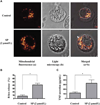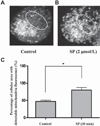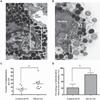Human mast cell degranulation and preformed TNF secretion require mitochondrial translocation to exocytosis sites: relevance to atopic dermatitis
- PMID: 21453958
- PMCID: PMC3381794
- DOI: 10.1016/j.jaci.2011.02.005
Human mast cell degranulation and preformed TNF secretion require mitochondrial translocation to exocytosis sites: relevance to atopic dermatitis
Abstract
Background: Mast cells derive from hematopoietic cell precursors and participate in tissue allergic, immune, and inflammatory processes. They secrete many mediators, including preformed TNF, in response to allergic, neuropeptide, and environmental triggers. However, regulation of mast cell degranulation is not well understood.
Objective: We investigated the role of mitochondrial dynamics in degranulation of human cultured mast cells.
Methods: Human umbilical cord blood-derived mast cells (hCBMCs) and Laboratory of Allergic Diseases 2 (LAD2) mast cells were examined by confocal and differential interference contrast microscopy during activation by IgE/antigen and substance P (SP). Mast cells in control and atopic dermatitis (AD) skin were evaluated by transmission electron microscopy. LAD2 cells were pretreated with mitochondrial division inhibitor, a dynamin-related protein 1 (Drp1) inhibitor, and small interfering RNA for Drp1, which is necessary for mitochondrial fission and translocation. Calcineurin and Drp1 gene expression was analyzed in stimulated LAD2 cells and AD skin biopsies.
Results: Stimulation of hCBMCs with IgE/antigen or LAD2 cells with SP leads to rapid (30 minutes) secretion of preformed TNF. Degranulation is accompanied by mitochondrial translocation from a perinuclear location to exocytosis sites. Extracellular calcium depletion prevents these effects, indicating calcium requirement. The calcium-dependent calcineurin and Drp1 are activated 30 minutes after SP stimulation. Reduction of Drp1 activity by mitochondrial division inhibitor and decrease of Drp1 expression using small interfering RNA inhibit mitochondrial translocation, degranulation, and TNF secretion. Mitochondrial translocation is also evident by transmission electron microscopy in skin mast cells from AD biopsies, in which gene expression of calcineurin, Drp1, and SP is higher than in normal skin.
Conclusion: Human mast cell degranulation requires mitochondrial dynamics, also implicated in AD.
Copyright © 2011 American Academy of Allergy, Asthma & Immunology. Published by Mosby, Inc. All rights reserved.
Conflict of interest statement
Disclosure of potential conflict of interest: T. C. Theoharides and B. Zhang are listed as the inventors of the provisional patent application US 61/405,414. The rest of the authors have declared that they have no conflict of interest.
Figures








References
-
- Galli SJ, Nakae S, Tsai M. Mast cells in the development of adaptive immune responses. Nat Immunol. 2005;6:135–142. - PubMed
-
- Theoharides TC, Kalogeromitros D. The critical role of mast cell in allergy and inflammation. Ann N Y Acad Sci. 2006;1088:78–99. - PubMed
-
- Gordon JR, Galli SJ. Mast cells as a source of both preformed and immunologically inducible TNF-α/cachectin. Nature. 1990;346:274–276. - PubMed
-
- Olszewski MB, Groot AJ, Dastych J, Knol EF. TNF trafficking to human mast cell granules: mature chain-dependent endocytosis. J Immunol. 2007;178:5701–5709. - PubMed
-
- Gibbs BF, Wierecky J, Welker P, Henz BM, Wolff HH, Grabbe J. Human skin mast cell rapidly release preformed and newly generated TNF-alpha and IL-8 following stimulation with anti-IgE and other secretagogues. Exp Dermatol. 2001;10:312–320. - PubMed
Publication types
MeSH terms
Substances
Grants and funding
LinkOut - more resources
Full Text Sources
Research Materials
Miscellaneous

